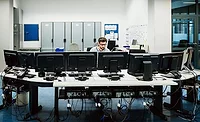4 ways to streamline security operations centers

Image from Pixabay
Security operations center (SOC) employees often monitor various technologies to maintain security at their facilities.
Today’s security systems include gunshot detection, mobile tracking tools, mass notification and business risk alerts, among others. That’s only a small sample of the many systems potentially involved in securing a facility and its people.
These disparate technologies can lead to SOC employees missing critical alerts when they are not integrated into a central view. Security leaders can follow these four minimum requirements when looking to integrate their security operations center (SOC):
1. Alarm details
Real-time alarms and alerts are triggered by various reasons, such as video motion and analytics, door events, intercom buttons, temperature sensors or Internet of Things (IoT) devices… the list goes on. When alerts are received, security command center operators need to know:
- The date and time of the alarm
- The type of alarm and what triggered the event
2. Location, location, location
Knowing the location of the alarm is critical to coordinating a response. SOC operators need to know:
- The building name, floor, area or zone where the alarm occurred
- The geo-location of the alarm automatically plotted on the map
3. Livestreams from nearby video
Situational awareness requires immediate live video feeds from cameras near the triggered event. The SOC counts on geospatial association with the ability to pinpoint each device to locate and show nearby live video feeds.
4. Alarm clips provide immediate context
Wherever and whenever possible, operators require video clips of triggered events. A well-integrated SOC should automatically capture a short clip from the camera nearest the event showing what triggered the alarm.
With a solid baseline for the necessary functionality from integrated security systems, security leaders can work to ensure compatibility across SOC technologies. By ensuring that alarms reach SOC operators; the surveillance feeds and other monitoring systems are organized; and SOC employees can produce reports of SOC activities, security leaders can reduce risk in their organizations.
Today’s SOC teams must protect more assets, people and locations, often using an expanding list of devices — many installed by different teams at different times. When combining security technologies, security teams can respond quicker to events and improve security outcomes.
Looking for a reprint of this article?
From high-res PDFs to custom plaques, order your copy today!








